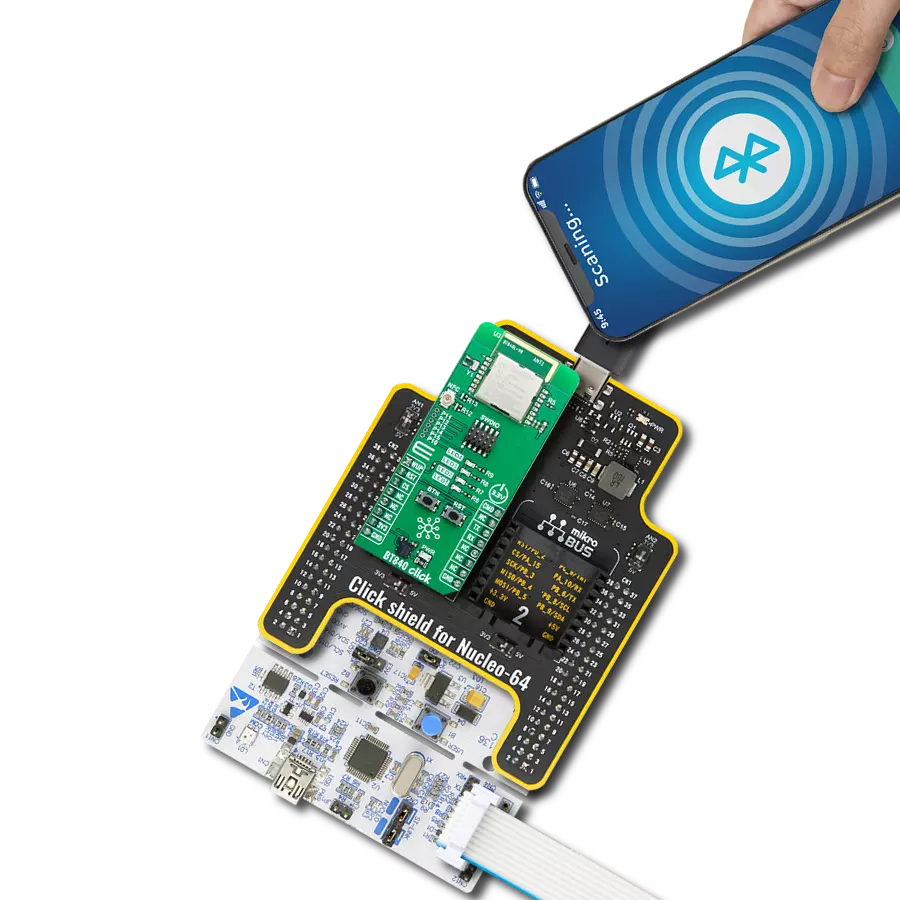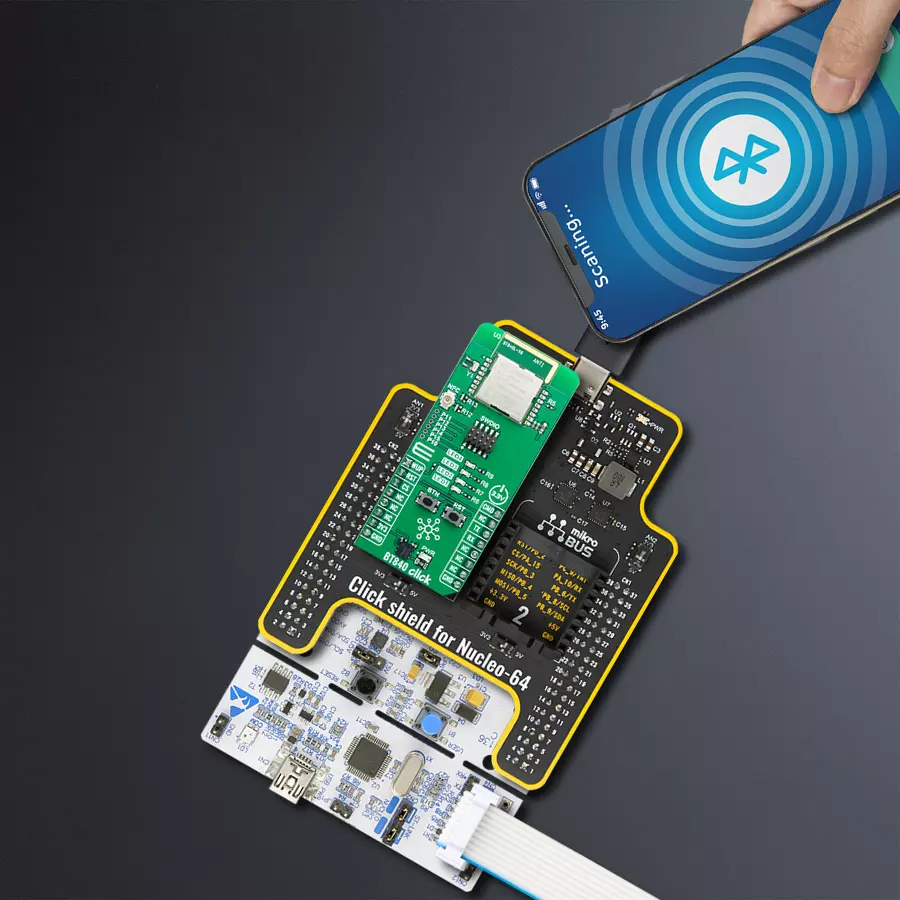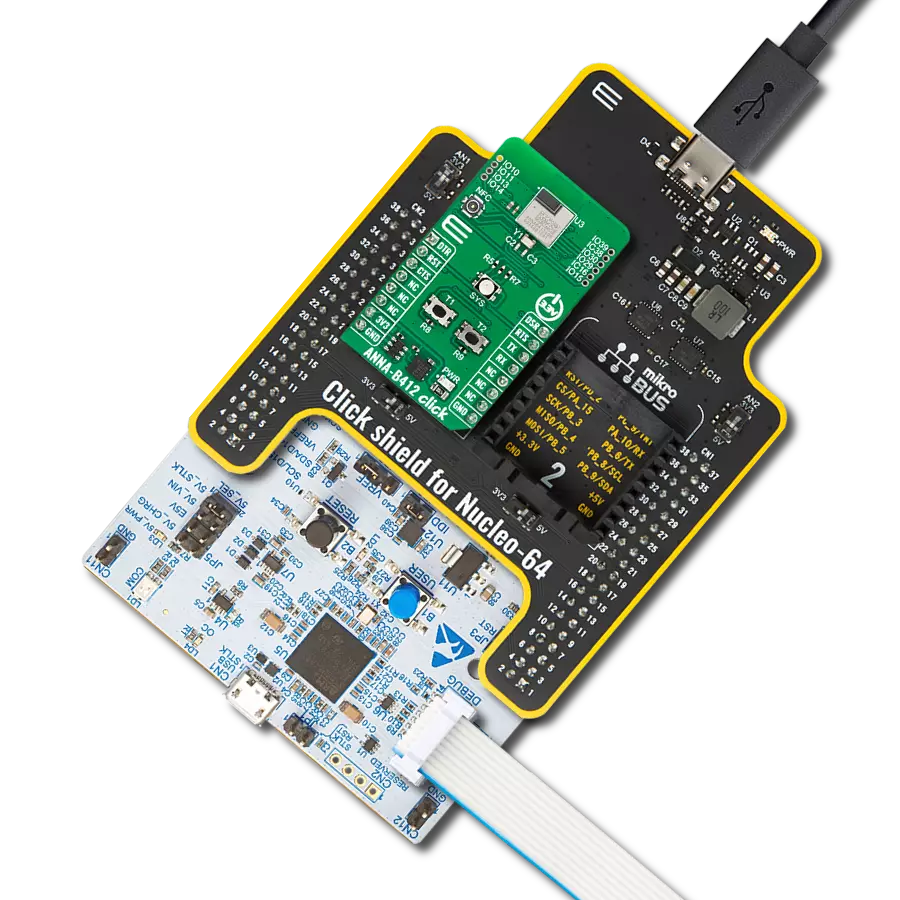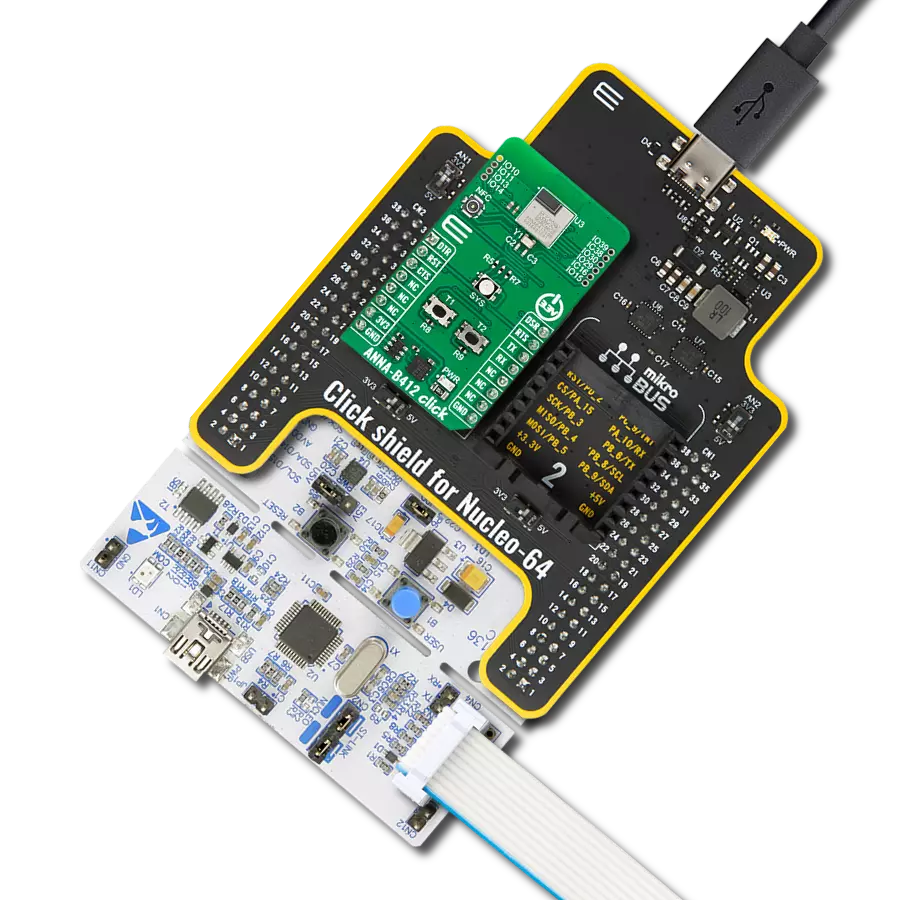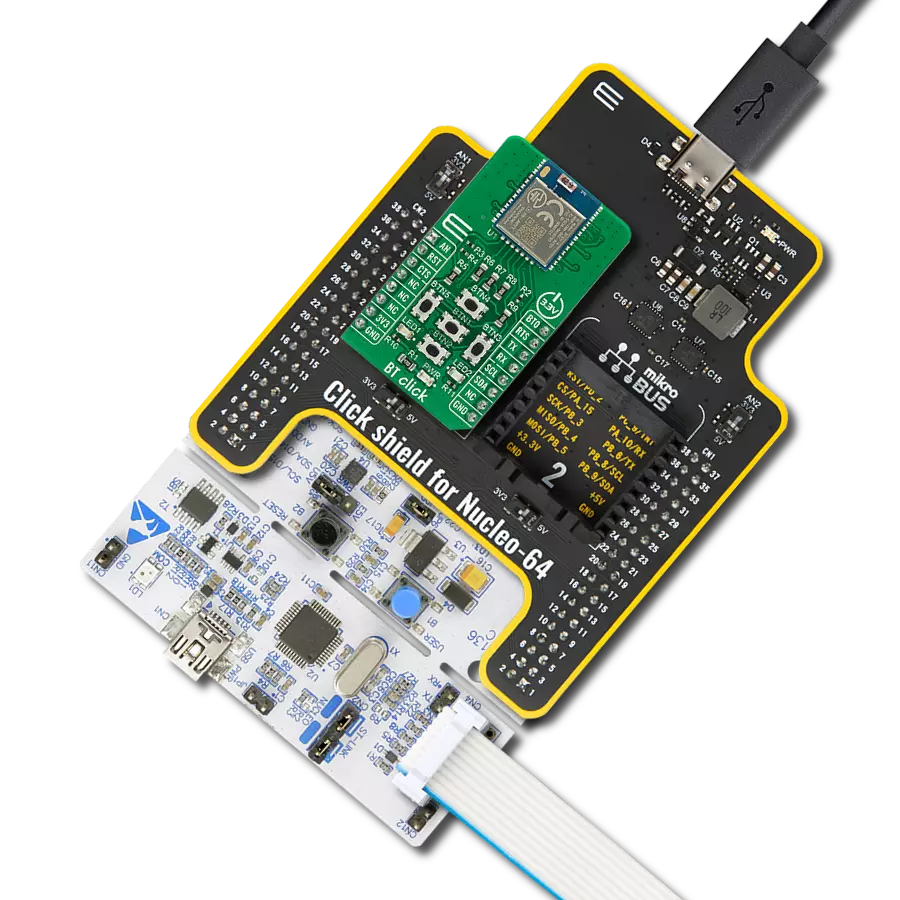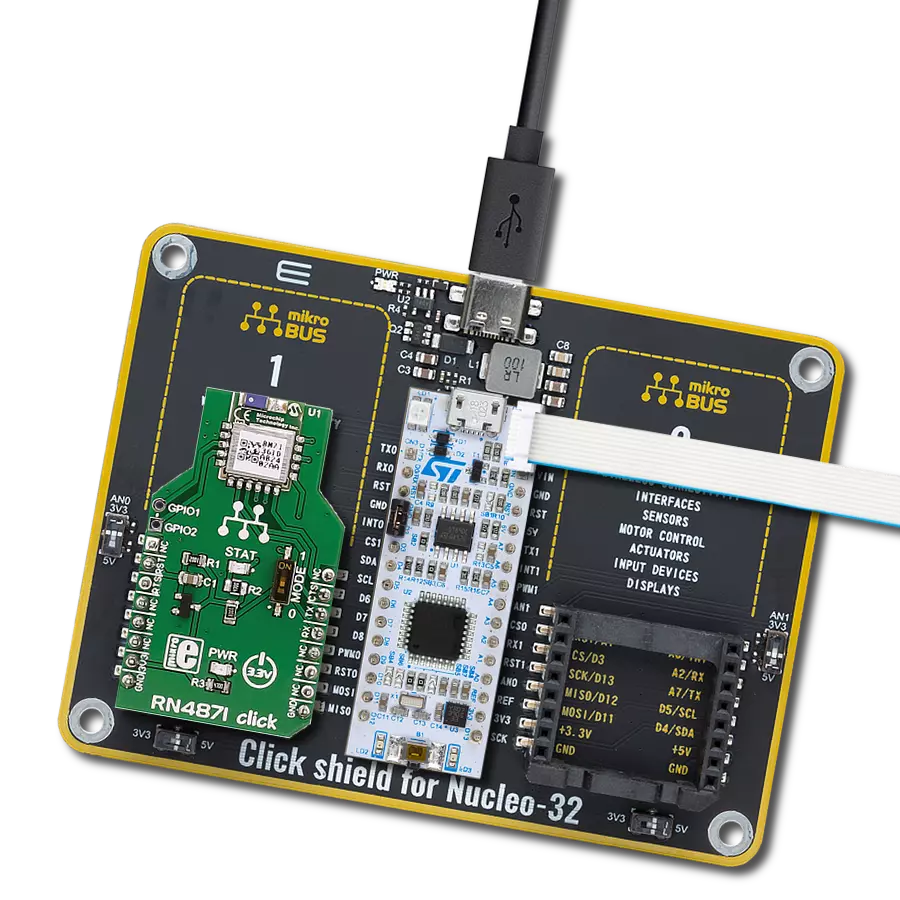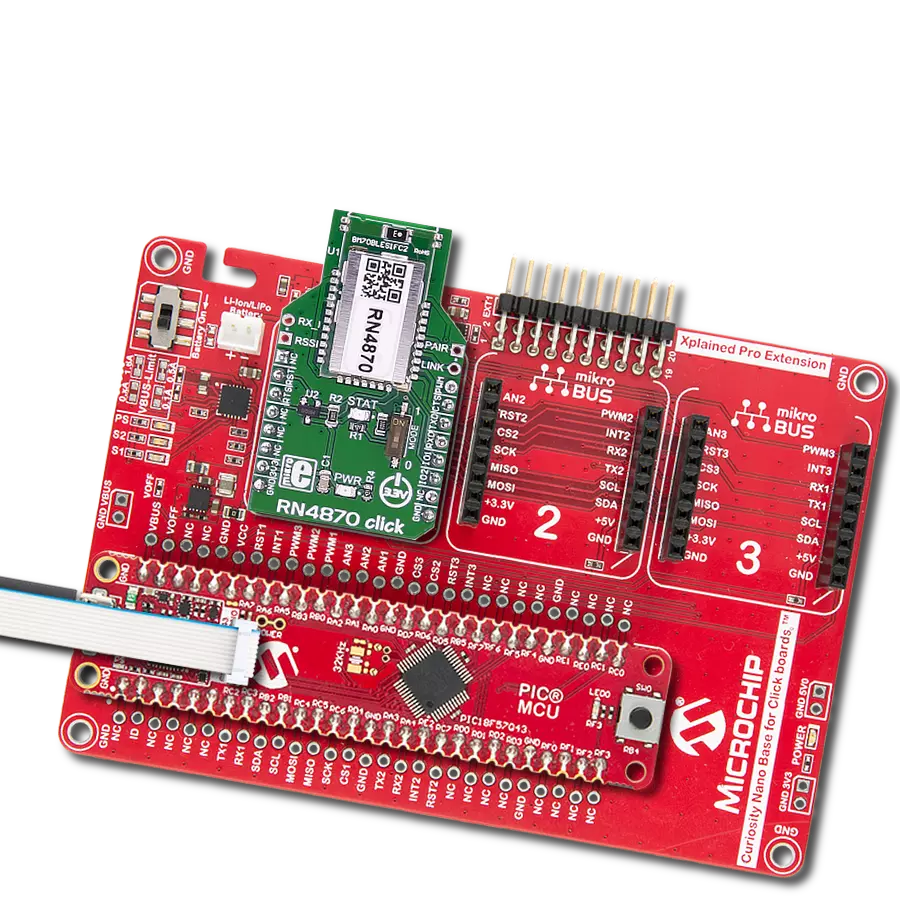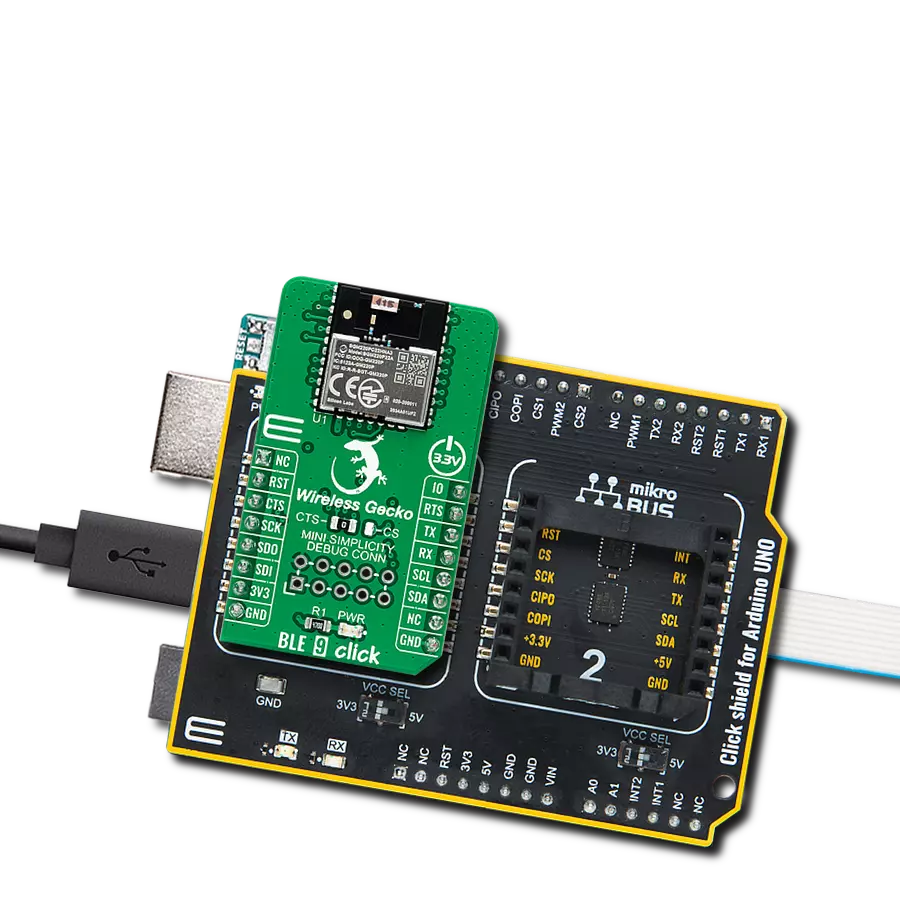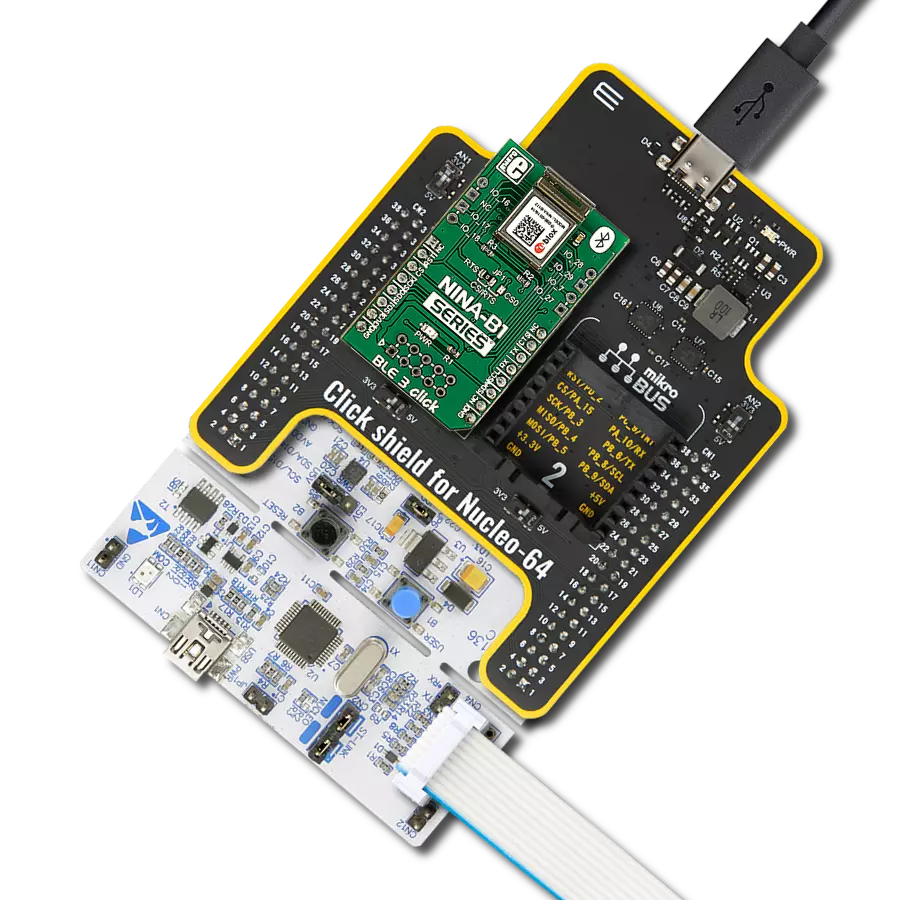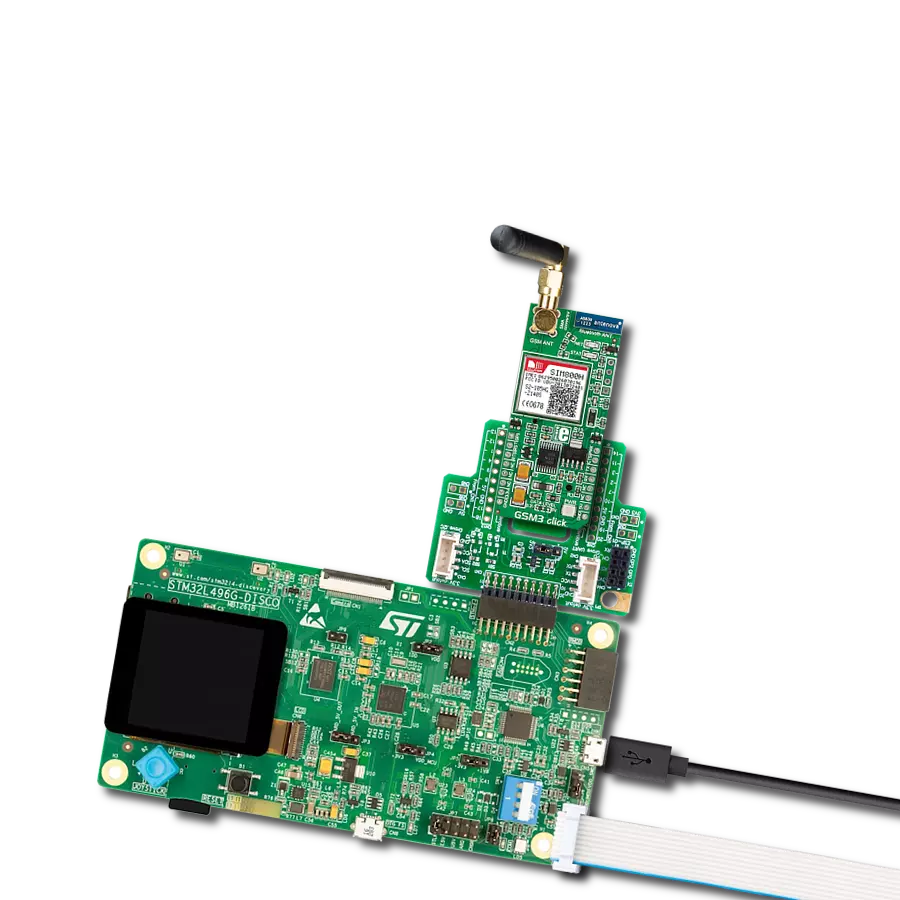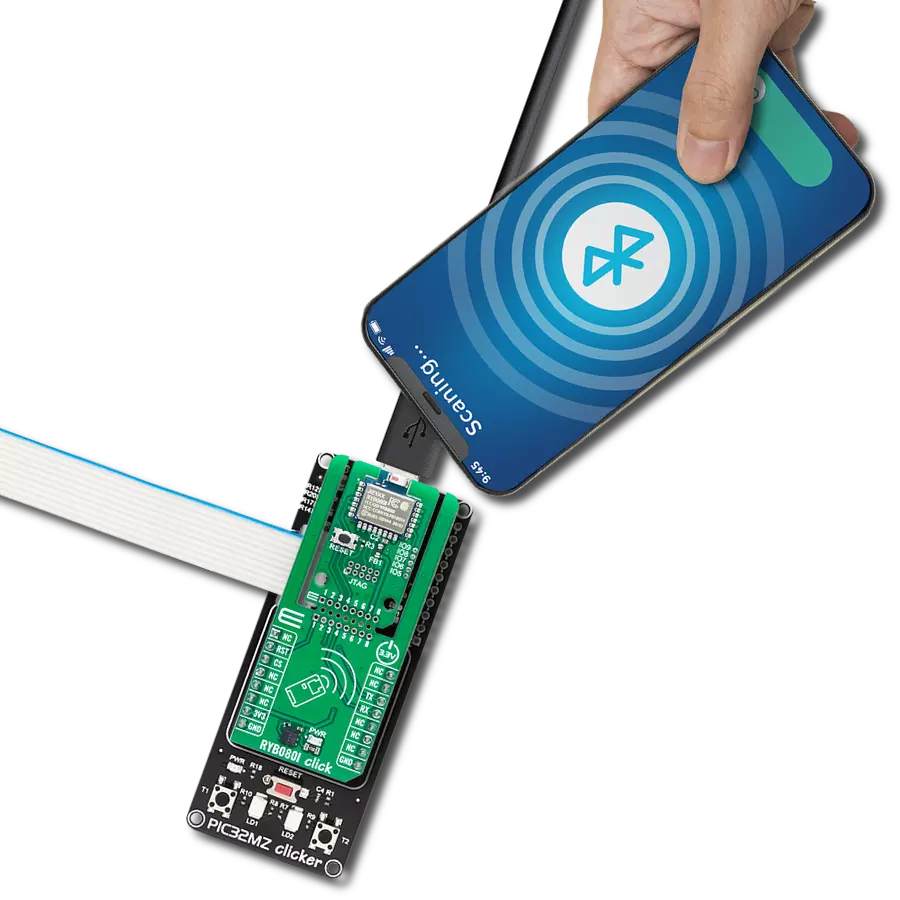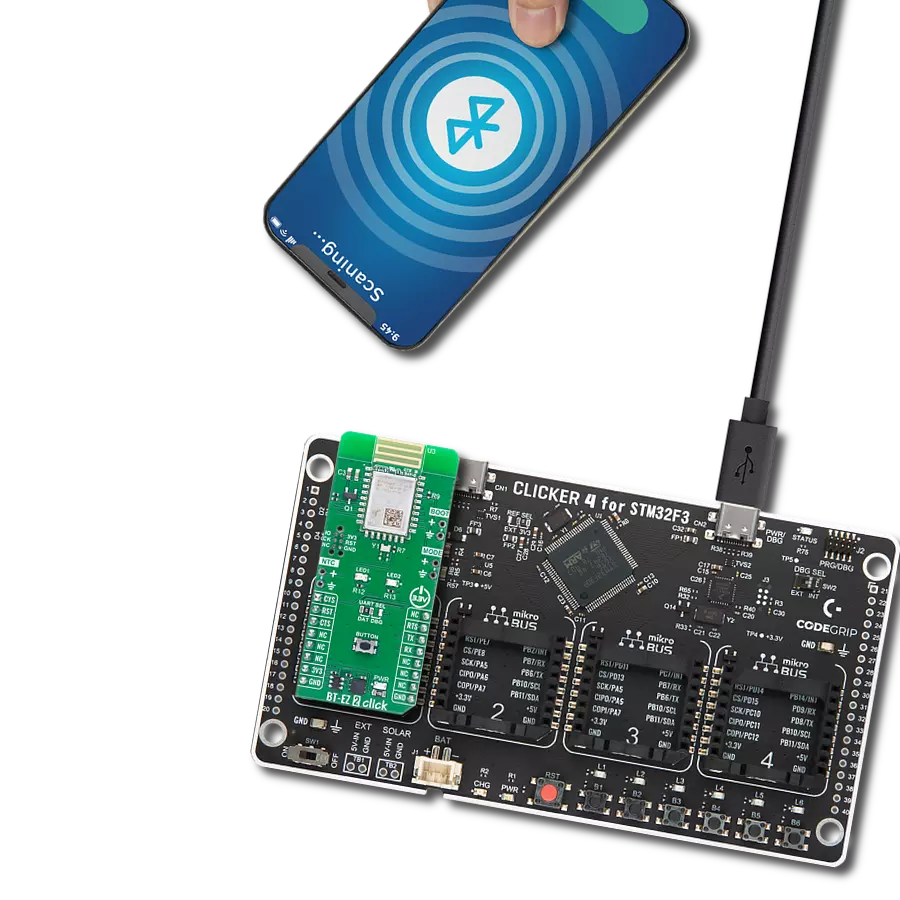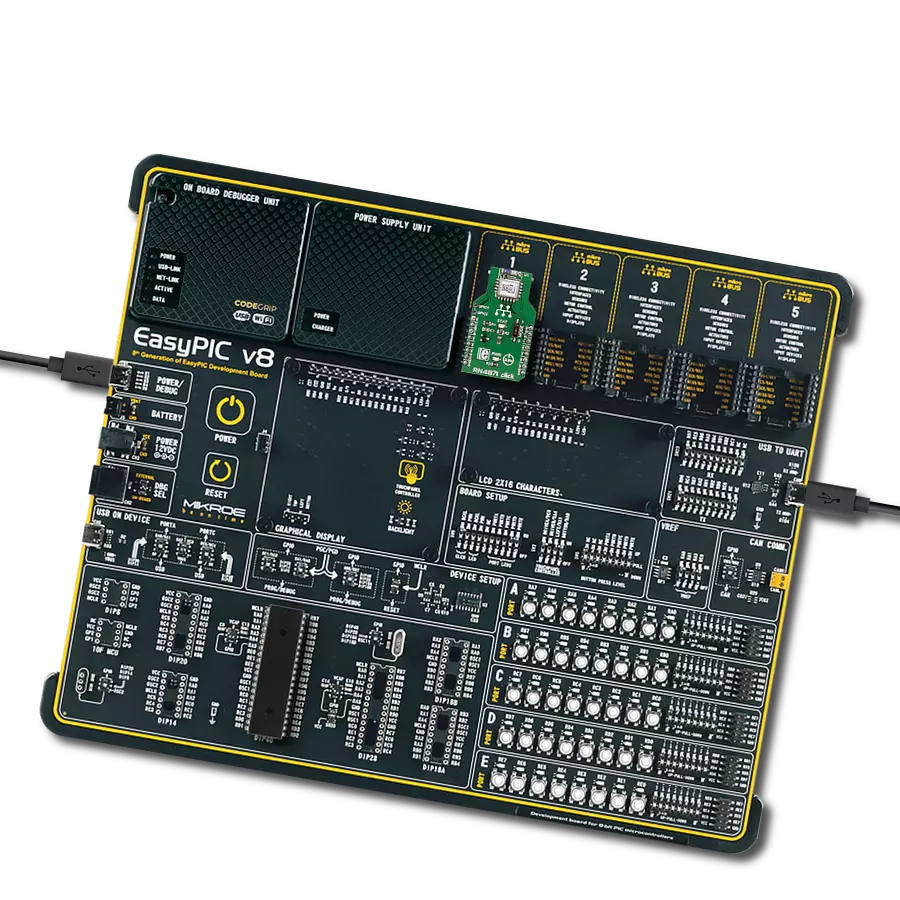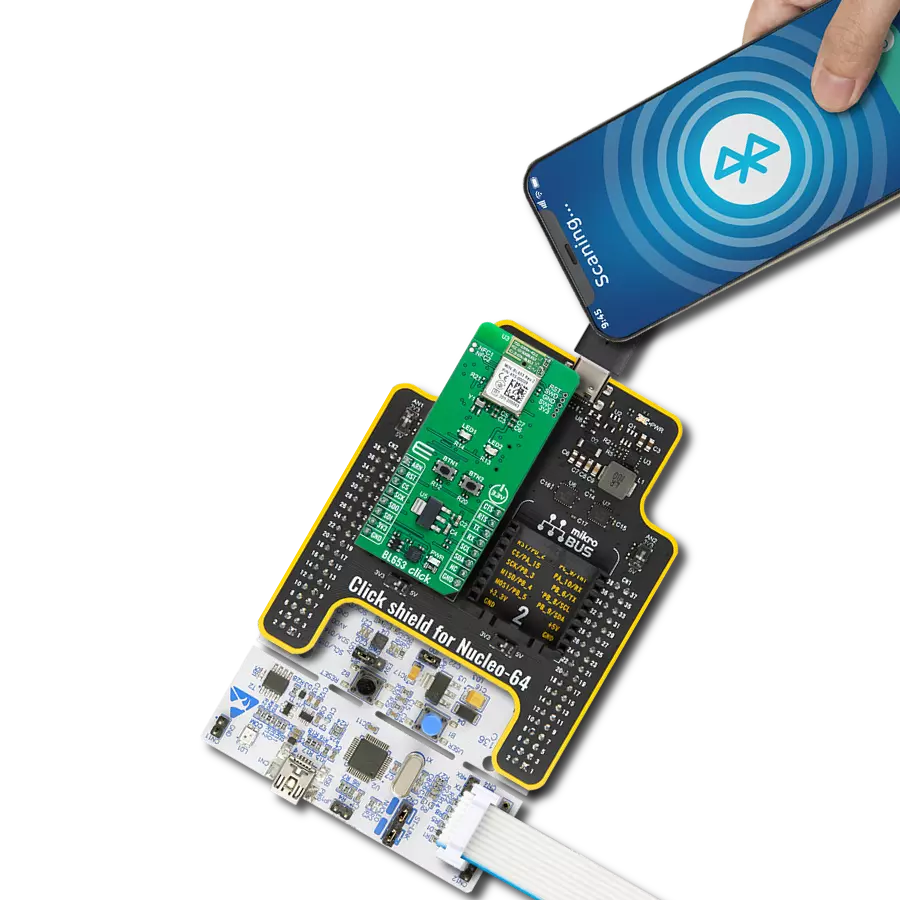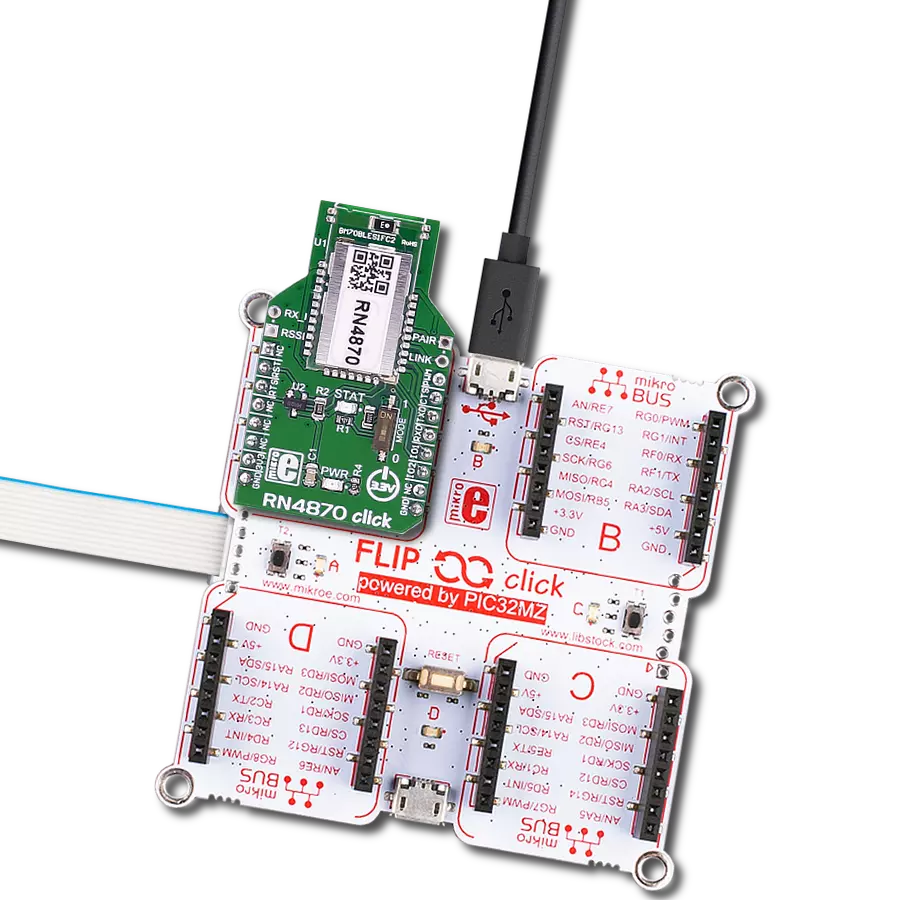为物联网设备提供安全且远距离的蓝牙低功耗 (Bluetooth LE) 连接
A
A
硬件概览
它是如何工作的?
BT840 Click 基于 Fanstel 的 BT840,这是一款超低功耗的蓝牙低能耗 (BLE) 模块,专为满足现代物联网应用的苛刻需求而设计。它集成了 Nordic Semiconductor 的 nRF52840 QIAA SoC,该 SoC 配备强大的 Cortex M4F MCU,拥有 1MB 的闪存和 256KB 的 RAM。此外,该模块还包括 ARM® TrustZone® Cryptocell-310 协处理器,确保敏感数据的强大行业级安全性。它通过标准 UART 接口与主 MCU 通信,简化了集成,便于开发高性能、低功耗的物联网系统。BT840 模块是一个完整的射频解决方案,配备嵌入式 2.4GHz 多协议收发器并支持 NFC 功能,使其适用于广泛的物联网用例。集成的 PCB 路径天线可实现可靠的通信,最大传输功率为 +4.9dBm,支持长距离性能。根据数据速率,它可以在 1Mbps 下实现高达 150 米的通信范围,在
125kbps 下实现高达 210 米的通信范围,为各种应用提供了卓越的灵活性。BT840 Click 非常适合需要高效且安全无线通信的物联网设备,支持超低功耗、长距离连接和高吞吐量。其先进功能(包括加密加速器)确保了数据传输的安全性和可靠性,满足工业、商业和消费物联网应用的关键需求。正如前述,BT840 Click 通过 UART 接口与主 MCU 通信,使用 TX 和 RX 引脚以默认波特率 115200bps 进行数据交换。除了 UART 接口外,板上还提供专用控制引脚以增强功能:WUP 引脚通过切换逻辑状态唤醒模块,而 CMD 引脚通过设置为高电平启用命令模式。BT840 Click 还包括一个外部 NFC 天线 u.Fl 接口,支持高级近场通信 (NFC) 功能。模块的 NFC 块支持 NFC-A 标签,允许从低功耗模式进行近距离检测和场唤醒功能。这一特性通过实现 Out-Of-Band (OOB) 蓝牙配对
简化了设备配对,优化了物联网系统的部署。此外,该板具有一个未焊接的 6 针接头,用于直接访问模块的 GPIO 信号,提供了灵活性以进行自定义配置和扩展功能。板上还配备了四个红色 LED 指示灯(LED1-LED4),可配置为用户特定的应用,另有两个按钮:一个 RST 按钮用于重置模块,另一个通用 BTN 按钮用于额外功能。为了实现串行线调试,SWDIO 连接引脚可用于调试和开发。在板的背面有低功耗 (LP) 断开跳线,通过切断这些跳线,可以断开 LED 和 ClickID 部分的电源,大大降低功耗,在对能耗敏感的应用中实现高效运行。该 Click 板™ 仅可在 3.3V 逻辑电压下运行。在使用其他逻辑电平的 MCU 之前,必须进行适当的逻辑电压电平转换。此外,该 Click 板™ 配备了功能库和示例代码,可用作进一步开发的参考。
功能概述
开发板
Nucleo-64 搭载 STM32F103RB MCU 提供了一种经济高效且灵活的平台,供开发者探索新想法并原型设计他们的项目。该板利用 STM32 微控制器的多功能性,使用户能够为他们的项目选择最佳的性能与功耗平衡。它配备了 LQFP64 封装的 STM32 微控制器,并包含了如用户 LED(同时作为 ARDUINO® 信号)、用户和复位按钮,以及 32.768kHz 晶体振荡器用于精确的计时操作等基本组件。Nucleo-64 板设计考虑到扩展性和灵活性,它特有的 ARDUINO® Uno
V3 扩展连接器和 ST morpho 扩展引脚头,提供了对 STM32 I/O 的完全访问,以实现全面的项目整合。电源供应选项灵活,支持 ST-LINK USB VBUS 或外部电源,确保在各种开发环境中的适应性。该板还配备了一个具有 USB 重枚举功能的板载 ST-LINK 调试器/编程器,简化了编程和调试过程。此外,该板设计旨在简化高级开发,它的外部 SMPS 为 Vcore 逻辑供电提供高效支持,支持 USB 设备全速或 USB SNK/UFP 全速,并内置加密功能,提升了项目的功效
和安全性。通过外部 SMPS 实验的专用连接器、 用于 ST-LINK 的 USB 连接器以及 MIPI® 调试连接器,提供了更多的硬件接口和实验可能性。开发者将通过 STM32Cube MCU Package 提供的全面免费软件库和示例得到广泛支持。这些,加上与多种集成开发环境(IDE)的兼容性,包括 IAR Embedded Workbench®、MDK-ARM 和 STM32CubeIDE,确保了流畅且高效的开发体验,使用户能够充分利用 Nucleo-64 板在他们的项目中的能力。
微控制器概述
MCU卡片 / MCU
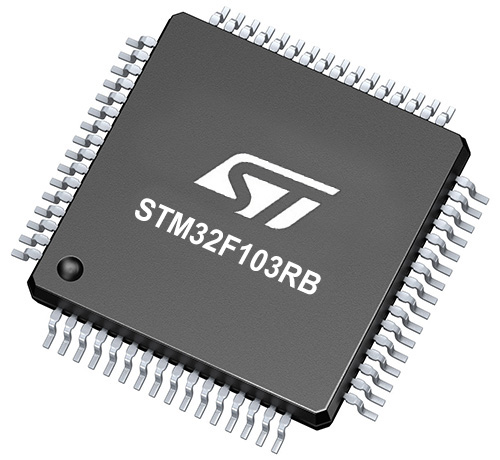
建筑
ARM Cortex-M3
MCU 内存 (KB)
128
硅供应商
STMicroelectronics
引脚数
64
RAM (字节)
20480
你完善了我!
配件
Click Shield for Nucleo-64 配备了两个专有的 mikroBUS™ 插座,使得所有的 Click board™ 设备都可以轻松地与 STM32 Nucleo-64 开发板连接。这样,Mikroe 允许其用户从不断增长的 Click boards™ 范围中添加任何功能,如 WiFi、GSM、GPS、蓝牙、ZigBee、环境传感器、LED、语音识别、电机控制、运动传感器等。您可以使用超过 1537 个 Click boards™,这些 Click boards™ 可以堆叠和集成。STM32 Nucleo-64 开发板基于 64 引脚封装的微控制器,采用 32 位 MCU,配备 ARM Cortex M4 处理器,运行速度为 84MHz,具有 512Kb Flash 和 96KB SRAM,分为两个区域,顶部区域代表 ST-Link/V2 调试器和编程器,而底部区域是一个实际的开发板。通过 USB 连接方便地控制和供电这些板子,以便直接对 Nucleo-64 开发板进行编程和高效调试,其中还需要额外的 USB 线连接到板子上的 USB 迷你接口。大多数 STM32 微控制器引脚都连接到了板子左右边缘的 IO 引脚上,然后连接到两个现有的 mikroBUS™ 插座上。该 Click Shield 还有几个开关,用于选择 mikroBUS™ 插座上模拟信号的逻辑电平和 mikroBUS™ 插座本身的逻辑电压电平。此外,用户还可以通过现有的双向电平转换器,使用任何 Click board™,无论 Click board™ 是否在 3.3V 或 5V 逻辑电压电平下运行。一旦将 STM32 Nucleo-64 开发板与我们的 Click Shield for Nucleo-64 连接,您就可以访问数百个工作于 3.3V 或 5V 逻辑电压电平的 Click boards™。
使用的MCU引脚
mikroBUS™映射器
“仔细看看!”
Click board™ 原理图

一步一步来
项目组装
实时跟踪您的结果
应用程序输出
1. 应用程序输出 - 在调试模式下,“应用程序输出”窗口支持实时数据监控,直接提供执行结果的可视化。请按照提供的教程正确配置环境,以确保数据正确显示。

2. UART 终端 - 使用UART Terminal通过USB to UART converter监视数据传输,实现Click board™与开发系统之间的直接通信。请根据项目需求配置波特率和其他串行设置,以确保正常运行。有关分步设置说明,请参考提供的教程。

3. Plot 输出 - Plot功能提供了一种强大的方式来可视化实时传感器数据,使趋势分析、调试和多个数据点的对比变得更加直观。要正确设置,请按照提供的教程,其中包含使用Plot功能显示Click board™读数的分步示例。在代码中使用Plot功能时,请使用以下函数:plot(insert_graph_name, variable_name);。这是一个通用格式,用户需要将“insert_graph_name”替换为实际图表名称,并将“variable_name”替换为要显示的参数。

软件支持
库描述
BT840 Click 演示应用程序使用 NECTO Studio开发,确保与 mikroSDK 的开源库和工具兼容。该演示设计为即插即用,可与所有具有 mikroBUS™ 插座的 开发板、入门板和 mikromedia 板完全兼容,用于快速实现和测试。
示例描述
本示例展示了如何使用 BT840 Click 板,通过处理来自连接的蓝牙 (BT) 设备的数据。
关键功能:
bt840_cfg_setup- 配置对象初始化函数。bt840_init- 初始化函数。bt840_cmd_run- 此函数向 Click 模块发送指定的命令。bt840_cmd_set- 此函数向 Click 模块的指定命令设置一个值。bt840_cmd_get- 此函数用于从 Click 模块的指定命令获取值。
应用初始化
初始化驱动程序和日志记录器。
应用任务
应用任务分为以下几个阶段:
BT840_POWER_UP:- 启动设备并读取系统信息。BT840_CONFIG_EXAMPLE:- 设置 BT 设备名称。BT840_EXAMPLE:- 执行一个 BT 终端示例,通过处理来自连接的 BT 设备的所有数据并发送适当的响应消息。
开源
代码示例
完整的应用程序代码和一个现成的项目可以通过NECTO Studio包管理器直接安装到NECTO Studio。 应用程序代码也可以在MIKROE的GitHub账户中找到。
/*!
* @file main.c
* @brief BT840 Click Example.
*
* # Description
* This example demonstrates the use of BT840 Click board by processing data
* from a connected BT device.
*
* The demo application is composed of two sections :
*
* ## Application Init
* Initializes the driver and logger.
*
* ## Application Task
* Application task is split in few stages:
* - BT840_POWER_UP:
* Powers up the device and reads the system information.
* - BT840_CONFIG_EXAMPLE:
* Sets the BT device name.
* - BT840_EXAMPLE:
* Performs a BT terminal example by processing all data from a connected BT device
* and sending back an adequate response messages.
*
* ## Additional Function
* - static void bt840_clear_app_buf ( void )
* - static void bt840_log_app_buf ( void )
* - static err_t bt840_process ( bt840_t *ctx )
* - static err_t bt840_read_response ( bt840_t *ctx, uint8_t *rsp )
* - static err_t bt840_power_up ( bt840_t *ctx )
* - static err_t bt840_config_example ( bt840_t *ctx )
* - static err_t bt840_example ( bt840_t *ctx )
*
* @note
* We have used the Serial Bluetooth Terminal smartphone application for the test.
*
* @author Stefan Filipovic
*
*/
#include "board.h"
#include "log.h"
#include "bt840.h"
#include "generic_pointer.h"
// Message content
#define MESSAGE_CONTENT "BT840 Click board - demo example."
// Local device name.
#define DEVICE_NAME "BT840 Click"
static bt840_t bt840;
static log_t logger;
// Application buffer size
#define APP_BUFFER_SIZE 600
#define PROCESS_BUFFER_SIZE 200
static uint8_t app_buf[ APP_BUFFER_SIZE ] = { 0 };
static int32_t app_buf_len = 0;
/**
* @brief Example states.
* @details Predefined enum values for application example state.
*/
typedef enum
{
BT840_POWER_UP = 1,
BT840_CONFIG_EXAMPLE,
BT840_EXAMPLE
} bt840_app_state_t;
static bt840_app_state_t app_state = BT840_POWER_UP;
/**
* @brief BT840 clearing application buffer.
* @details This function clears memory of application buffer and reset its length.
* @note None.
*/
static void bt840_clear_app_buf ( void );
/**
* @brief BT840 log application buffer.
* @details This function logs data from application buffer to USB UART.
* @note None.
*/
static void bt840_log_app_buf ( void );
/**
* @brief BT840 data reading function.
* @details This function reads data from device and concatenates data to application buffer.
* @param[in] ctx : Click context object.
* See #bt840_t object definition for detailed explanation.
* @return @li @c 0 - Read some data.
* @li @c -1 - Nothing is read.
* See #err_t definition for detailed explanation.
* @note None.
*/
static err_t bt840_process ( bt840_t *ctx );
/**
* @brief BT840 read response function.
* @details This function waits for a response message, reads and displays it on the USB UART.
* @param[in] ctx : Click context object.
* See #bt840_t object definition for detailed explanation.
* @param[in] rsp Expected response.
* @return @li @c 0 - OK response.
* @li @c -2 - Timeout error.
* @li @c -3 - Command error.
* See #err_t definition for detailed explanation.
* @note None.
*/
static err_t bt840_read_response ( bt840_t *ctx, uint8_t *rsp );
/**
* @brief BT840 power up function.
* @details This function powers up the device, and reads the system information.
* @param[in] ctx : Click context object.
* See #bt840_t object definition for detailed explanation.
* @return @li @c 0 - OK.
* @li @c != 0 - Read response error.
* See #err_t definition for detailed explanation.
* @note None.
*/
static err_t bt840_power_up ( bt840_t *ctx );
/**
* @brief BT840 config example function.
* @details This function sets the BT device name.
* @param[in] ctx : Click context object.
* See #bt840_t object definition for detailed explanation.
* @return @li @c 0 - OK.
* @li @c != 0 - Read response error.
* See #err_t definition for detailed explanation.
* @note None.
*/
static err_t bt840_config_example ( bt840_t *ctx );
/**
* @brief BT840 example function.
* @details This function performs a BT terminal example by processing all data from
* a connected BT device and sending back an adequate response messages.
* @param[in] ctx : Click context object.
* See #bt840_t object definition for detailed explanation.
* @return @li @c 0 - OK.
* @li @c != 0 - Read response error.
* See #err_t definition for detailed explanation.
* @note None.
*/
static err_t bt840_example ( bt840_t *ctx );
void application_init ( void )
{
log_cfg_t log_cfg; /**< Logger config object. */
bt840_cfg_t bt840_cfg; /**< Click config object. */
/**
* Logger initialization.
* Default baud rate: 115200
* Default log level: LOG_LEVEL_DEBUG
* @note If USB_UART_RX and USB_UART_TX
* are defined as HAL_PIN_NC, you will
* need to define them manually for log to work.
* See @b LOG_MAP_USB_UART macro definition for detailed explanation.
*/
LOG_MAP_USB_UART( log_cfg );
log_init( &logger, &log_cfg );
log_info( &logger, " Application Init " );
// Click initialization.
bt840_cfg_setup( &bt840_cfg );
BT840_MAP_MIKROBUS( bt840_cfg, MIKROBUS_1 );
if ( UART_ERROR == bt840_init( &bt840, &bt840_cfg ) )
{
log_error( &logger, " Communication init." );
for ( ; ; );
}
log_info( &logger, " Application Task " );
app_state = BT840_POWER_UP;
log_printf( &logger, ">>> APP STATE - POWER UP <<<\r\n\n" );
}
void application_task ( void )
{
switch ( app_state )
{
case BT840_POWER_UP:
{
if ( BT840_OK == bt840_power_up( &bt840 ) )
{
app_state = BT840_CONFIG_EXAMPLE;
log_printf( &logger, ">>> APP STATE - CONFIG EXAMPLE <<<\r\n\n" );
}
break;
}
case BT840_CONFIG_EXAMPLE:
{
if ( BT840_OK == bt840_config_example( &bt840 ) )
{
app_state = BT840_EXAMPLE;
log_printf( &logger, ">>> APP STATE - EXAMPLE <<<\r\n\n" );
}
break;
}
case BT840_EXAMPLE:
{
bt840_example( &bt840 );
break;
}
default:
{
log_error( &logger, " APP STATE." );
break;
}
}
}
int main ( void )
{
/* Do not remove this line or clock might not be set correctly. */
#ifdef PREINIT_SUPPORTED
preinit();
#endif
application_init( );
for ( ; ; )
{
application_task( );
}
return 0;
}
static void bt840_clear_app_buf ( void )
{
memset( app_buf, 0, app_buf_len );
app_buf_len = 0;
}
static void bt840_log_app_buf ( void )
{
for ( int32_t buf_cnt = 0; buf_cnt < app_buf_len; buf_cnt++ )
{
log_printf( &logger, "%c", app_buf[ buf_cnt ] );
}
}
static err_t bt840_process ( bt840_t *ctx )
{
uint8_t rx_buf[ PROCESS_BUFFER_SIZE ] = { 0 };
int32_t overflow_bytes = 0;
int32_t rx_cnt = 0;
int32_t rx_size = bt840_generic_read( ctx, rx_buf, PROCESS_BUFFER_SIZE );
if ( ( rx_size > 0 ) && ( rx_size <= APP_BUFFER_SIZE ) )
{
if ( ( app_buf_len + rx_size ) > APP_BUFFER_SIZE )
{
overflow_bytes = ( app_buf_len + rx_size ) - APP_BUFFER_SIZE;
app_buf_len = APP_BUFFER_SIZE - rx_size;
memmove ( app_buf, &app_buf[ overflow_bytes ], app_buf_len );
memset ( &app_buf[ app_buf_len ], 0, overflow_bytes );
}
for ( rx_cnt = 0; rx_cnt < rx_size; rx_cnt++ )
{
if ( rx_buf[ rx_cnt ] )
{
app_buf[ app_buf_len++ ] = rx_buf[ rx_cnt ];
}
}
return BT840_OK;
}
return BT840_ERROR;
}
static err_t bt840_read_response ( bt840_t *ctx, uint8_t *rsp )
{
#define READ_RESPONSE_TIMEOUT_MS 30000
uint32_t timeout_cnt = 0;
bt840_clear_app_buf ( );
bt840_process( ctx );
while ( ( 0 == strstr( app_buf, rsp ) ) &&
( 0 == strstr( app_buf, BT840_RSP_FAIL ) ) )
{
bt840_process( ctx );
if ( timeout_cnt++ > READ_RESPONSE_TIMEOUT_MS )
{
bt840_log_app_buf( );
bt840_clear_app_buf( );
log_error( &logger, " Timeout!" );
return BT840_ERROR_TIMEOUT;
}
Delay_ms( 1 );
}
Delay_ms ( 200 );
bt840_process( ctx );
bt840_log_app_buf( );
if ( strstr( app_buf, rsp ) )
{
log_printf( &logger, "--------------------------------\r\n" );
return BT840_OK;
}
return BT840_ERROR_CMD;
}
static err_t bt840_power_up ( bt840_t *ctx )
{
err_t error_flag = BT840_OK;
log_printf( &logger, ">>> Reset device.\r\n" );
bt840_set_cmd_mode( &bt840 );
bt840_reset_device( &bt840 );
bt840_wakeup_device( &bt840 );
while ( BT840_OK == bt840_process( ctx ) )
{
bt840_log_app_buf( );
bt840_clear_app_buf ( );
}
log_printf( &logger, "--------------------------------\r\n" );
log_printf( &logger, ">>> Factory reset.\r\n" );
bt840_cmd_run( &bt840, BT840_CMD_DEFAULT_RESET );
error_flag |= bt840_read_response( &bt840, BT840_RSP_OK );
log_printf( &logger, ">>> Check communication.\r\n" );
bt840_cmd_run( &bt840, BT840_CMD_AT );
error_flag |= bt840_read_response( &bt840, BT840_RSP_OK );
log_printf( &logger, ">>> Get software version.\r\n" );
bt840_cmd_get( ctx, BT840_CMD_GET_SW_VERSION );
error_flag |= bt840_read_response( ctx, BT840_RSP_OK );
log_printf( &logger, ">>> Get MAC address.\r\n" );
bt840_cmd_get( ctx, BT840_CMD_GET_MAC );
error_flag |= bt840_read_response( ctx, BT840_RSP_OK );
return error_flag;
}
static err_t bt840_config_example ( bt840_t *ctx )
{
err_t error_flag = BT840_OK;
log_printf( &logger, ">>> Set device name to \"%s\".\r\n", ( char * ) DEVICE_NAME );
bt840_cmd_set( ctx, BT840_CMD_DEVICE_NAME, DEVICE_NAME );
error_flag |= bt840_read_response( ctx, BT840_RSP_OK );
Delay_ms ( 1000 );
Delay_ms ( 1000 );
log_printf( &logger, ">>> Save settings.\r\n" );
bt840_cmd_set( &bt840, BT840_CMD_SAVE_SETTINGS, "1" );
error_flag |= bt840_read_response( ctx, BT840_RSP_OK );
log_printf( &logger, ">>> Reboot.\r\n" );
bt840_cmd_run( ctx, BT840_CMD_RESET );
error_flag |= bt840_read_response( ctx, BT840_RSP_OK );
return error_flag;
}
static err_t bt840_example ( bt840_t *ctx )
{
err_t error_flag = BT840_OK;
uint32_t timeout_cnt = 0;
uint8_t data_len = 0;
uint8_t byte_cnt = 0;
uint8_t * __generic_ptr start_ptr = NULL;
#define BT_TERMINAL_TIMEOUT_MS 60000
#define BT_TERMINAL_MESSAGE_FREQ_MS 5000
#define TERMINATION_CMD "END"
#define TERMINATION_RESPONSE "END command received, the connection will be terminated in a few seconds."
#define TERMINATION_TIMEOUT "Timeout, closing the connection in a few seconds."
#define NEW_LINE_STRING "\r\n"
log_printf( &logger, ">>> Waiting for a BT peer to establish connection with the Click board...\r\n" );
for ( ; ; )
{
bt840_clear_app_buf( );
if ( BT840_OK == bt840_process( ctx ) )
{
Delay_ms ( 200 );
bt840_process( ctx );
bt840_log_app_buf( );
if ( strstr( app_buf, BT840_RSP_CONNECTED ) )
{
log_printf( &logger, "--------------------------------\r\n" );
log_printf( &logger, ">>> BT peer has connected.\r\n" );
bt840_set_data_mode( &bt840 );
break;
}
}
}
log_printf( &logger, ">>> Waiting for data (up to 60 seconds)...\r\n" );
log_printf( &logger, ">>> Connection will be terminated if the Click receives an \"END\" string.\r\n" );
for ( ; ; )
{
bt840_clear_app_buf( );
if ( BT840_OK == bt840_process( ctx ) )
{
Delay_ms ( 100 );
timeout_cnt = 0;
bt840_process( ctx );
bt840_log_app_buf( );
start_ptr = strstr( app_buf, BT840_RSP_RECEIVE );
if ( start_ptr )
{
start_ptr += strlen ( BT840_RSP_RECEIVE );
data_len = *start_ptr;
log_printf( &logger, "<<< Received data (HEX): " );
for ( byte_cnt = 0; byte_cnt < data_len; byte_cnt++ )
{
log_printf( &logger, "0x%.2X ", *( start_ptr + byte_cnt + 1 ) );
}
log_printf( &logger, "\r\n" );
log_printf( &logger, "<<< Received data (STR): %s", ( start_ptr + 1 ) );
log_printf( &logger, "--------------------------------\r\n" );
}
if ( strstr( app_buf, TERMINATION_CMD ) )
{
log_printf( &logger, ">>> Terminating connection on demand.\r\n" );
data_len = strlen ( TERMINATION_RESPONSE ) + strlen ( NEW_LINE_STRING );
bt840_generic_write ( ctx, &data_len, 1 );
bt840_generic_write ( ctx, TERMINATION_RESPONSE, strlen ( TERMINATION_RESPONSE ) );
bt840_generic_write ( ctx, NEW_LINE_STRING, strlen ( NEW_LINE_STRING ) );
Delay_ms ( 100 );
error_flag |= bt840_read_response( ctx, BT840_RSP_SEND );
log_printf( &logger, ">>> Disconnecting BT peer.\r\n" );
bt840_set_cmd_mode( &bt840 );
bt840_cmd_set( ctx, BT840_CMD_DISCONNECT, "1" );
error_flag |= bt840_read_response( ctx, BT840_RSP_DISCONNECTED );
break;
}
else if ( strstr( app_buf, BT840_RSP_DISCONNECTED ) )
{
log_printf( &logger, ">>> BT peer has disconnected.\r\n" );
break;
}
}
timeout_cnt++;
if ( 0 == ( timeout_cnt % BT_TERMINAL_MESSAGE_FREQ_MS ) )
{
log_printf( &logger, ">>> Sending \"%s\" message to connected device.\r\n", ( char * ) MESSAGE_CONTENT );
data_len = strlen ( MESSAGE_CONTENT ) + strlen ( NEW_LINE_STRING );
bt840_generic_write ( ctx, &data_len, 1 );
bt840_generic_write ( ctx, MESSAGE_CONTENT, strlen ( MESSAGE_CONTENT ) );
bt840_generic_write ( ctx, NEW_LINE_STRING, strlen ( NEW_LINE_STRING ) );
Delay_ms ( 100 );
error_flag |= bt840_read_response( ctx, BT840_RSP_SEND );
}
if ( BT_TERMINAL_TIMEOUT_MS < timeout_cnt )
{
log_printf( &logger, ">>> Terminating connection due to 60s timeout expiration.\r\n" );
data_len = strlen ( TERMINATION_TIMEOUT ) + strlen ( NEW_LINE_STRING );
bt840_generic_write ( ctx, &data_len, 1 );
bt840_generic_write ( ctx, TERMINATION_TIMEOUT, strlen ( TERMINATION_TIMEOUT ) );
bt840_generic_write ( ctx, NEW_LINE_STRING, strlen ( NEW_LINE_STRING ) );
Delay_ms ( 100 );
error_flag |= bt840_read_response( ctx, BT840_RSP_SEND );
log_printf( &logger, ">>> Disconnecting BT peer.\r\n" );
bt840_set_cmd_mode( &bt840 );
bt840_cmd_set( ctx, BT840_CMD_DISCONNECT, "1" );
error_flag |= bt840_read_response( ctx, BT840_RSP_DISCONNECTED );
break;
}
Delay_ms ( 1 );
}
log_printf( &logger, ">>> Reboot.\r\n" );
bt840_cmd_run( ctx, BT840_CMD_RESET );
error_flag |= bt840_read_response( ctx, BT840_RSP_OK );
return error_flag;
}
// ------------------------------------------------------------------------ END
额外支持
资源
类别:蓝牙/蓝牙低功耗
